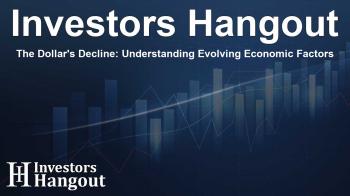The Dollar's Decline: Understanding Evolving Economic Factors

The Dollar Faces Challenges Amid Economic Uncertainty
The dollar recently showed signs of a rebound, gaining over 3% in July after a notably poor first half. However, this upward trend appears to be faltering as concerns regarding stagflation intensify. In this current climate, experts suggest that the dollar's resurgence may not be sustainable as economic indicators paint a worrying picture.
Stagflation: A Key Concern for the Dollar
The bearish outlook on the dollar is largely attributed to a troubling mix of softening labor metrics alongside persistently high inflation—an economic situation commonly referred to as stagflation. This situation, characterized by stagnant growth and rising prices, generally spells trouble for the dollar, particularly when the Federal Reserve adopts a dovish stance.
Impact on Federal Reserve Policies
Bank of America analysts are expressing significant concern regarding upcoming monetary policy decisions as economic turmoil continues. They emphasize that the potential for interest rate cuts in the face of rising inflation could lead to further depreciation of the dollar. Alex Cohen, a strategist at the bank, conveyed this sentiment, noting that the Federal Reserve might find itself in a unique position of needing to lower rates during a stagflationary period.
Revised Forecasts for Euro-Dollars Exchange Rate
The current dollar weakness has prompted financial institutions like Bank of America to reassess their forecasts for the euro-dollar exchange rate. The expectation is that the euro could rise to 1.20 against the dollar by the end of the year, up from previous levels close to 1.16. By 2026, this pairing might reach as high as 1.25, indicating a potential 25% surge from earlier 2025 figures.
Structural Issues Threatening Dollar Stability
In addition to monetary policy implications, there are deeper structural issues that could threaten the dollar's value. Bank of America highlights concerns about the integrity of U.S. data and governance, which may discourage foreign investment and confidence in American economic metrics. Analysts stress that growing worries over the independence of the Federal Reserve and the politicization of economic data gathering could lead to unfavorable market conditions.
Market Reactions to Inflationary Pressures
Should inflation remain stubbornly high, there is a possibility that the Fed may be forced to forgo easing expectations, potentially leading to a temporary uplift in the dollar. Yet, analysts caution that even an uptick would likely be short-lived, as the prevailing economic headwinds are expected to continue affecting dollar performance adversely.
Preparing for Future Economic Scenarios
In scenarios of prolonged stagflation, Bank of America posits that lower real and nominal U.S. interest rates combined with a steeper yield curve could drive stronger performance in commodities and large-cap stocks. This environment would likely exacerbate the dollar's decline. Investors need to remain vigilant as these dynamics unfold, adjusting their strategies accordingly.
Frequently Asked Questions
What factors are leading to the dollar's decline?
The dollar is facing a decline largely due to stagflation fears, characterized by weak economic growth and persistently high inflation.
How is the Federal Reserve reacting to current economic trends?
The Federal Reserve may consider cutting interest rates in response to rising inflation, which could further weaken the dollar.
What are Bank of America's predictions for the euro-dollar exchange rate?
Bank of America forecasts that the euro could rise to 1.20 against the dollar by year-end, with potential further increases in subsequent years.
What are the long-term implications of economic uncertainty for the dollar?
Long-term economic uncertainty could lead to lower foreign investment and a depreciation of the dollar as confidence in U.S. economic data wanes.
Can the dollar recover in the short term?
While there might be temporary recoveries, the overall expectation is that the dollar will continue to struggle under current economic conditions.
About The Author
Contact Hannah Lewis privately here. Or send an email with ATTN: Hannah Lewis as the subject to contact@investorshangout.com.
About Investors Hangout
Investors Hangout is a leading online stock forum for financial discussion and learning, offering a wide range of free tools and resources. It draws in traders of all levels, who exchange market knowledge, investigate trading tactics, and keep an eye on industry developments in real time. Featuring financial articles, stock message boards, quotes, charts, company profiles, and live news updates. Through cooperative learning and a wealth of informational resources, it helps users from novices creating their first portfolios to experts honing their techniques. Join Investors Hangout today: https://investorshangout.com/
The content of this article is based on factual, publicly available information and does not represent legal, financial, or investment advice. Investors Hangout does not offer financial advice, and the author is not a licensed financial advisor. Consult a qualified advisor before making any financial or investment decisions based on this article. This article should not be considered advice to purchase, sell, or hold any securities or other investments. If any of the material provided here is inaccurate, please contact us for corrections.

